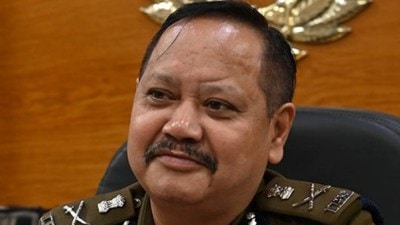Punishment becomes crime
Meanwhile, elsewhere in the Republic, in the forgotten corners of dusty police stations, lathi and roller continue to make harsh contact wit...

Meanwhile, elsewhere in the Republic, in the forgotten corners of dusty police stations, lathi and roller continue to make harsh contact with flesh and bone. So secretly is this done, so discreetly, that the democratic nation which houses these modest citadels of terror can continue to believe that it is indeed a democracy. But can civil or political rights have any meaning if they are not informed by that most basic of rights which every human being is naturally heir to — human rights?
In 1996-’97 there were 188 and 700 deaths in police and judicial custody respectively, as reported in the recently released National Human Rights Commission (NHRC) annual report. In the course of 12 months, 888 people died at the hands of the country’s guardians of the law. These are the official figures. Since the actual number of such deaths will never be known, let us look a little closer at them.
Even a cursory reading reveals two trends. First, that the death count from ’96-’97 is twice that of the previousyear. Second, three states alone account for more than half these deaths. It doesn’t require any great perspicacity to discern which these states are: Maharashtra tops the list with an unprecedented 201 deaths, Uttar Pradesh comes next with 171, followed by Andhra Pradesh with 97.
The NHRC, in its well-meaning fashion, attributes the increase in this macabre total to the fact that it had issued "repeated instructions that information regarding such tragic occurrences must not be suppressed". This may be the case, but that still does not justify the unconscionably high number of extra-judicial killings that mark law enforcement in India.
Unfortunately, the NHRC report does not explain why Maharashtra should have experienced this orgy of blood-letting, why its figure of police custody deaths should have jumped from 9 in ’95-’96 to 21 the next year, or its judicial custody deaths risen from 34 to an alarming 180 in the same period. What sudden provocation made this state’s police forget basic civilisationalnorms? There was, of course, the threat of the mafia in the city of Mumbai, but couldn’t it have been met through normal policing and judicial processes?Just one example would suffice to illustrate how the system worked. On August 26, 1997, a 22-year-old street vendor, who sold chana outside Bandra West railway station, was spirited away by the Crime Branch of the Mumbai police. His family looked desperately for him everywhere. On September 2, his sister was taken to the JJ Hospital Morgue where she was able to identify the body of the missing person. It bore four bullet marks, and traces of tyre marks. The police insisted that the dead man was a goonda with mafia connections, yet they didn’t bother to either establish this legally or inform his family of his death. Abu Saima’s is just one name that figured, perhaps, in that infamous list of 201 deaths that Maharashtra has against its name.
In Andhra Pradesh, the NHRC did follow up on a complaint by the Andhra Pradesh Civil Liberties Committee,alleging that the state police were staging "fake encounters" to eliminate members of the People’s War Group and their supporters. It further alleged that these "executive eliminations" of people were replacing the due processes of the law, with the result that in some cases those who were not involved in any Naxalite activity or only remotely connected with the PWG were being killed.
Through its investigations, the Commission discovered that the police had made no prior attempt to arrest the deceased persons and that in none of these "encounters" had police personnel received any injury to even remotely suggest that their actions were done in self-defence. What’s more, they indulged in massive cover-up operations under which entries were made in the respective police station claiming that the deceased had tried to kill policemen and were therefore guilty of attempted murder. Once thus condemned in the FIRs, the cases were closed without investigation.
The NHRC Report states unequivocally: "The police donot possess unchartered rights to kill any person with impunity," adding that political problems must essentially be resolved by political means. Yet, going by the Commission’s own report, the great majority of human rights violations that took place in the country were perpetrated by the police and on occasion the Army, when called upon to discharge civilian duties. These agencies had clearly behaved on numerous occasions as rank predators, accountable to no institution or person.
But what is more disturbing than the actual incidents is the apparent indifference of politicians to them. It is as if the mass cremation of bodies labelled unidentified’ or the beating to death of a boy accused of theft by the local police have tacitly become a part of governance. It provokes no horror, no expression of moral outrage.
The NHRC has been urging the Central and state governments to get India to accede to the 1984 Convention against torture and other forms of cruel, inhuman and degrading treatment or punishmentfor some years now. So far it has drawn a blank, with the majority of chief ministers still evidently reluctant to give up their "right" to torture their citizens. They do not seem to realise that the Indian Constitution had, in any case, outlawed such practices nearly 50 years ago. Similarly, the videotaping of postmortems done on victims of alleged custodial violence was another vital step that the Commission had long been championing. To date, the chief ministers of some of the states with the worst records — Maharashtra, Rajasthan, UP and Delhi — are resisting it.
If the Commission’s exertions are not to be rendered into mere cosmetic exercises, a renewed will to reform the criminal justice system in the country has to emerge from its latest report. There are numerous aspects to be addressed, from small but vital steps like the regular monitoring of police stations by senior officers for checking the use of third-degree methods to improving prison conditions and amending archaic laws.
What is atstake here is the very definition of what constitutes humanity. The NHRC Report quotes some moving lines from the Supreme Court judgment in D.K. Basu vs the State of West Bengal: "Whenever human dignity is wounded, civilisation takes a step backward. The flag of humanity on each occasion must fly at half-mast." For far too long has the tricolour flown at half-mast.



- 01
- 02
- 03
- 04
- 05




























